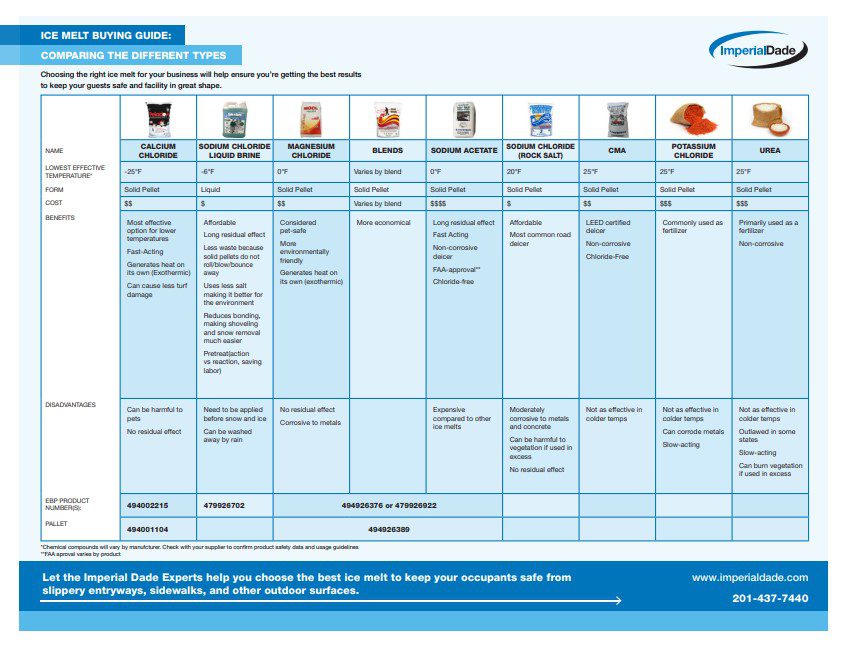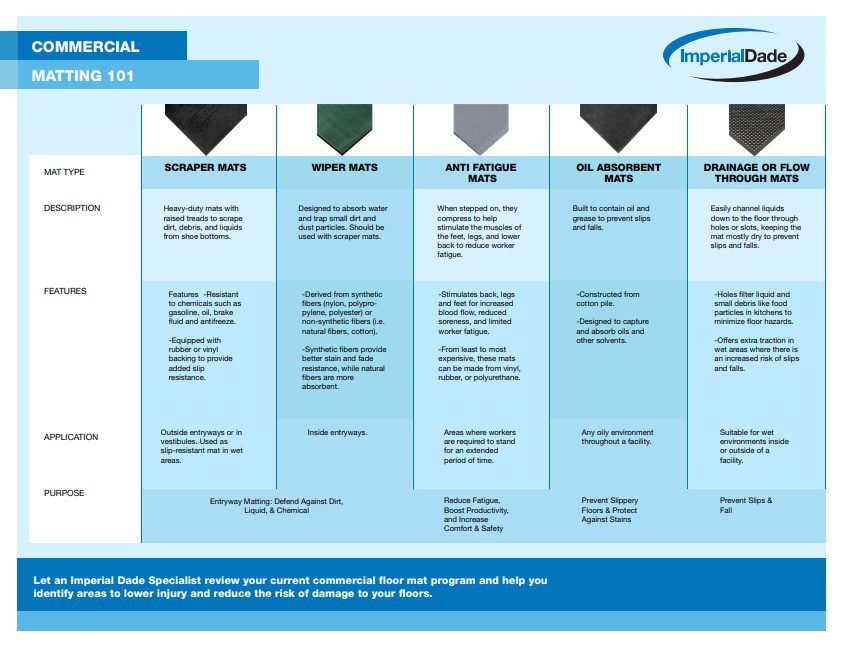When creating a winter floor care bundle for your facility, consider the winter weather hazards you dealt with last year, the problems that arose from them, and what products you needed to address those issues.
Did you deal with hazy, white ice melt residue on your hard floors? Stock up on winter floor neutralizer. Or, maybe you dealt with wet floors during heavy snowfalls? Invest in a solid matting system.
Most businesses face an array of similar issues each year. That’s why our experts put together a winter floor care bundle with some of the most useful products for addressing common winter-related issues.
Winter floor care issues we’ll be addressing in this article:
- Prevent Moisture and Rock Salt From Being Tracked Inside
- Address Oversaturated Winter Floor Mats
- Reduce Slip and Fall Risks in Your Facility
- Mitigate Slip-and-Fall Hazards Outside Your Facility
- Eliminate White Streaks from Ice Melt Residue
Prevent Moisture and Rock Salt From Being Tracked Inside
It’s no secret by now that foot traffic in winter will put your floors to the test. Snow, sleet, and rock salt get tracked in by occupant’s shoes, wreaking havoc on your floors. But, what if those contaminants never made it past the main entryway? Enter, winter floor mats.
Winter floor mats may just be the single most important tenet of our floor care bundle. Floor mats are responsible for catching roughly 90% of the dirt and soil that would otherwise have been tracked into your facility. Plus, an effective floor matting program will be absorbent. Their ability to prevent moisture from entering your facility is key to deterring moisture and rock salt from making it to your floors.
For the most effective matting system, the goal should be for no moisture or rock salt to be left on any footwear after it leaves the mat.
Experts recommend at least 15 ft of matting, from outside to the inner foyer, composed of both scraping and drying mats, to achieve that goal. This should effectively prevent most moisture and rock salt from getting tracked into your facility.
Don’t forget to refer to our commercial entry mat guide for everything you need to know to create your own matting system.
Already have winter floor mats in place? Learn how to clean floor mats in 6 easy steps with this tutorial.
Address Oversaturated Winter Floor Mats
While great at preventing most moisture from being tracked onto your floor, winter floor mats aren’t failproof. During high-traffic periods, and especially during heavy snowfalls, it doesn’t take long for your outdoor mats to become waterlogged. After that, the rest of the matting system will become waterlogged too.
The best solution to this problem is a wet/dry vac. Wet/dry vacs are the quickest way to put a mat back into action after becoming oversaturated with water. A regular vacuum can’t be used on a wet mat, while an air drier can take hours to dry off the mat, and then you have to vacuum it to remove contaminants. A wet/dry vac is able to quickly and efficiently dry the mat while unloading any contaminants from it, allowing it to go back to use.
It is important for this process to be quick because a waterlogged mat isn’t just useless for picking up residue, it also ceases to prevent moisture from entering your facility. That means a wet mat result in wet floors, and a higher risk of falls.
It is vital to keep those winter floor mats in constant use if you want them to continue keeping the floors dry and clean.
Reduce Slip-and-Fall Risks in Your Facility
Unfortunately for your floors, people may elect to walk around the entry mats and unknowingly track water into the facility. At this point, you need to focus on increasing awareness in order to reduce slip and fall risks. A great way to do that is with proper signage.
An often overlooked aspect of the floor care routine, wet floor signs are key to communicating to people that the floor is wet, and there is a slip-and-fall hazard in place. This is especially important for promoting the visibility of wet zones in high-traffic areas, where there is an increased risk of slip-and-falls.
One measure you can take to actively deter slip-and-fall hazards is to address them as they arise. If a floor is particularly moisture-ridden, or there is a visible pool of water, break out the autoscrubber and take care of it. If your equipment is in use at that moment, grab a mop kit to soak up any moisture.
If you’re unable to take immediate action, wet floors signs are a great way to raise awareness surrounding wet zones and other areas that are at high risk for pooling. With all of this in mind, don’t forget that it’s also important to take measures against slip-and-fall hazards outdoors.
Mitigate Slip-and-Fall Hazards Outside Your Facility
Slips and falls are not only prevalent inside, but also outside, and it’s important for facility managers to be aware of this as it’s also their responsibility to mitigate the risk.
Ice melt is a winter must-have if you want to be proactive against slip-and-falls during the icy season. It can be used both as a preventative measure, as well as a responsive measure, for deterring the formation of hazardous ice and snow.

Ice melt may be a saving grace for winter floor prep, but it’s not a one-size-fits-all product. That’s why it’s important to know exactly what kind is the right one for your facility, and how to properly use it. There are dozens of different varieties, each with its own chemical makeup and use case. To find the right product for you, check out our article, What is Ice Melt? Selecting The Best Ice Melt For Your Facility.
Everything you need to know about ice melt including how to select the best one for your facility based on surface type, lowest effective melting temperature, & more!

As for where best to apply ice melt, parking lots, walkways, stairways, sidewalks, and around the main entryway are all good locations. The goal is to prevent personal injury from falling, so targeting areas that see high foot traffic, have low visibility, or are already prone to slips are all good choices.
Eliminate White Streaks from Ice Melt Residue
It is inevitable that ice melt residue will make its way into your building at some point in the winter. It’s a product that is used by so many that even if you don’t elect to use it around your facility, chances are someone will track it in from elsewhere. That’s why we recommend stocking up on floor neutralizers.
Not to be confused with neutral floor cleaner, floor neutralizer is a vital component of your winter floor care routine due to its effectiveness as a floor neutralizer and ability to combat white streaks left behind from salt and ice melt residue.
Pro Tip: Watch this video to learn the key differences between floor cleaner and floor neutralizer:
Floor neutralizer does an exceptional job at removing white swirl marks from vinyl, terrazzo, and ceramic tile flooring. It can also be used to remove salt stains from carpeted surfaces.
Floor neutralizer makes cleaning efforts a lot simpler because it is specifically made to address the residue left behind by harsh chemicals used during the winter time. It is able to do this because it is slightly more acidic than your typical neutral cleaner.
Final Thoughts
Needless to say, there’s more to a full-fledged winter floor care bundle than what we’ve gone over, but this product bundle should be more than enough to get you started.
For all the winter floor care products you need, contact an Imperial Dade sales rep today. We offer an unparalleled selection of equipment, materials, and supplies that will keep your floors and facility looking clean all year round. We offer free consultations where our experts can review your facility on-site or virtually to identify gaps in your winter floor care program.
Our specialists are available day-in and day-out to offer their expertise in creating a winter floor care bundle that is right for your operation.
Check Out These Related Articles:
- Winter Floor Care: 4 Costly Floor Cleaning Mistakes to Avoid
- How to Keep Your School’s Floor Clean & Safe During the Winter
- Winter Floor Maintenance Tips: 4 Tips to Protect Your Facility’s Floors
- Liquid Ice Melt vs Solid Ice Melt: What’s the Difference?
- What is Ice Melt? Selecting The Best Ice Melt For Your Facility
![Winter Floor Prep: Creating a Winter Floor Care Bundle [+ Product Recs]](https://imperialdade.blog/wp-content/uploads/2022/11/College-Campus-in-Winter.jpg)
